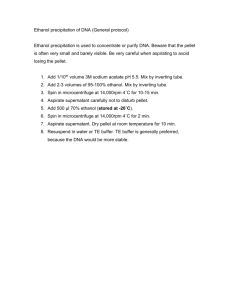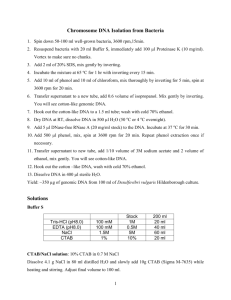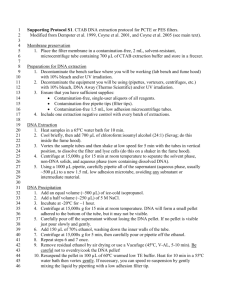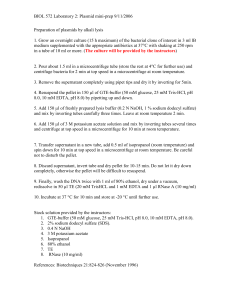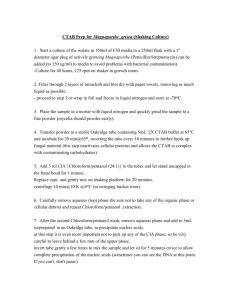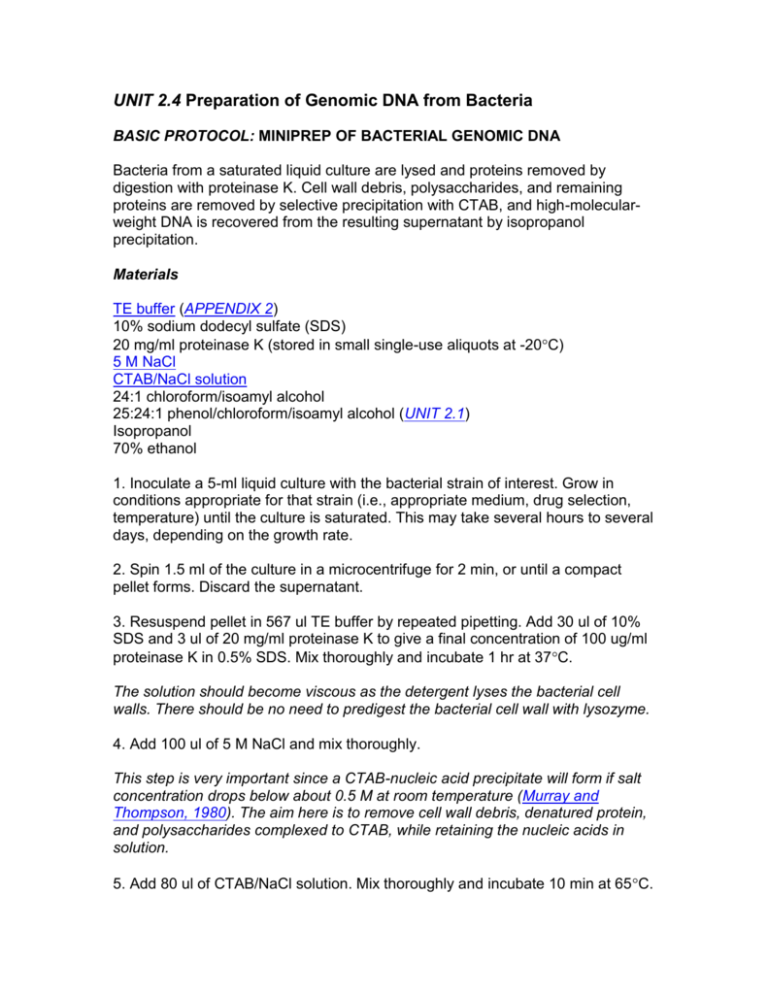
UNIT 2.4 Preparation of Genomic DNA from Bacteria
BASIC PROTOCOL: MINIPREP OF BACTERIAL GENOMIC DNA
Bacteria from a saturated liquid culture are lysed and proteins removed by
digestion with proteinase K. Cell wall debris, polysaccharides, and remaining
proteins are removed by selective precipitation with CTAB, and high-molecularweight DNA is recovered from the resulting supernatant by isopropanol
precipitation.
Materials
TE buffer (APPENDIX 2)
10% sodium dodecyl sulfate (SDS)
20 mg/ml proteinase K (stored in small single-use aliquots at -20C)
5 M NaCl
CTAB/NaCl solution
24:1 chloroform/isoamyl alcohol
25:24:1 phenol/chloroform/isoamyl alcohol (UNIT 2.1)
Isopropanol
70% ethanol
1. Inoculate a 5-ml liquid culture with the bacterial strain of interest. Grow in
conditions appropriate for that strain (i.e., appropriate medium, drug selection,
temperature) until the culture is saturated. This may take several hours to several
days, depending on the growth rate.
2. Spin 1.5 ml of the culture in a microcentrifuge for 2 min, or until a compact
pellet forms. Discard the supernatant.
3. Resuspend pellet in 567 ul TE buffer by repeated pipetting. Add 30 ul of 10%
SDS and 3 ul of 20 mg/ml proteinase K to give a final concentration of 100 ug/ml
proteinase K in 0.5% SDS. Mix thoroughly and incubate 1 hr at 37C.
The solution should become viscous as the detergent lyses the bacterial cell
walls. There should be no need to predigest the bacterial cell wall with lysozyme.
4. Add 100 ul of 5 M NaCl and mix thoroughly.
This step is very important since a CTAB-nucleic acid precipitate will form if salt
concentration drops below about 0.5 M at room temperature (Murray and
Thompson, 1980). The aim here is to remove cell wall debris, denatured protein,
and polysaccharides complexed to CTAB, while retaining the nucleic acids in
solution.
5. Add 80 ul of CTAB/NaCl solution. Mix thoroughly and incubate 10 min at 65C.
6. Add an approximately equal volume (0.7 to 0.8 ml) of chloroform/isoamyl
alcohol, mix thoroughly, and spin 4 to 5 min in a microcentrifuge.
This extraction removes CTAB-protein/polysaccharide complexes. A white
interface should be visible after centrifugation.
7. Remove aqueous, viscous supernatant to a fresh microcentrifuge tube, leaving
the interface behind. Add an equal volume of phenol/chloroform/isoamyl alcohol,
extract thoroughly, and spin in a microcentrifuge for 5 min.
With some bacterial strains the interface formed after chloroform extraction is not
compact enough to allow easy removal of the supernatant. In such cases, most
of the interface can be fished out with a sterile toothpick before removal of any
supernatant. Remaining CTAB precipitate is then removed in the
phenol/chloroform extraction.
8. Transfer the supernatant to a fresh tube. Add 0.6 vol isopropanol to precipitate
the nucleic acids (there is no need to add salt since the NaCl concentration is
already high). Shake the tube back and forth until a stringy white DNA precipitate
becomes clearly visible. At this point it is possible to transfer the pellet to a fresh
tube containing 70% ethanol by hooking it onto the end of a micropipet that has
been heat-sealed and bent in a Bunsen flame. Alternatively, the precipitate can
be pelleted by spinning briefly at room temperature.
If no stringy DNA precipitate forms in the above step, this implies that the DNA
has sheared into relatively low-molecular-weight pieces. If this is acceptable, i.e.,
if DNA is to be digested to completion with restriction endonucleases for
Southern blot analysis, chromosomal DNA can often still be recovered simply by
pelleting the precipitate in a microcentrifuge.
9. Wash the DNA with 70% ethanol to remove residual CTAB and respin 5 min at
room temperature to repellet it. Carefully remove the supernatant and briefly dry
the pellet in a lyophilizer.
10. Redissolve the pellet in 100 ul TE buffer.
This may take some time (up to 1 hr) since the DNA is of high molecular weight.
15 ul of this DNA will typically digest to completion with 10 U EcoRI in 1 hr, which
is sufficient to be clearly visible on an agarose gel, or to give a good signal during
Southern hybridization.
From Current Protocols in Molecular Biology Online
Copyright © 2001 John Wiley & Sons, Inc. All rights reserved.
REAGENTS AND SOLUTIONS
CTAB/NaCl solution (10% CTAB in 0.7 M NaCl)
Dissolve 4.1 g NaCl in 80 ml water and slowly add 10 g CTAB
(hexadecyltrimethyl ammonium bromide) while heating and stirring. If necessary,
heat to 65C to dissolve. Adjust final volume to 100 ml.

